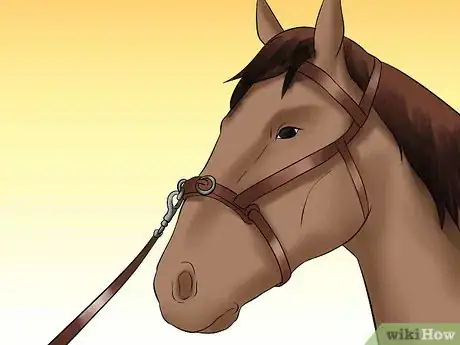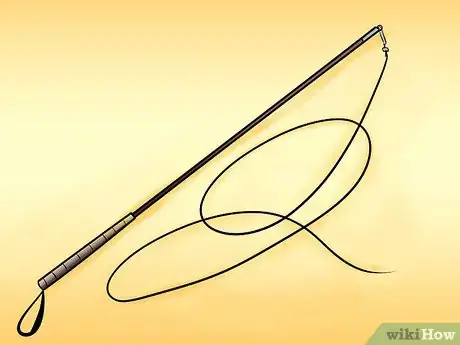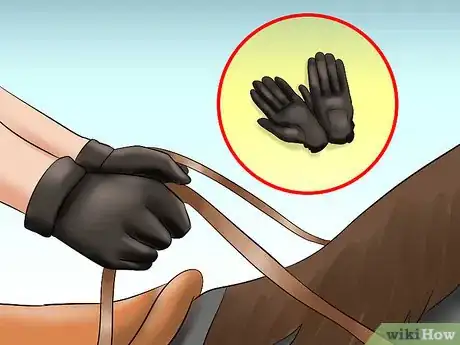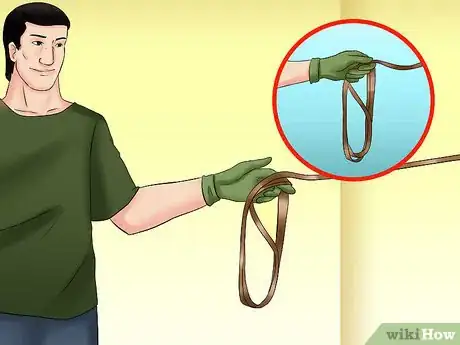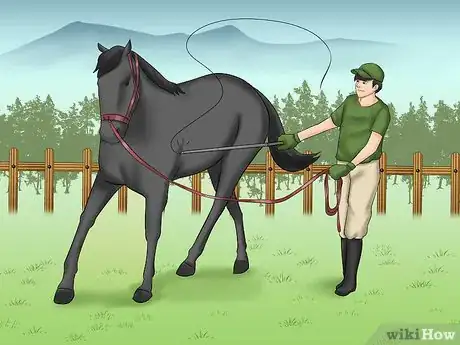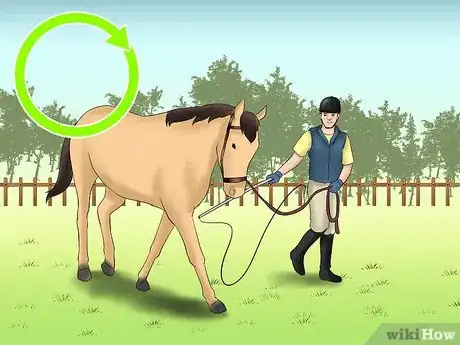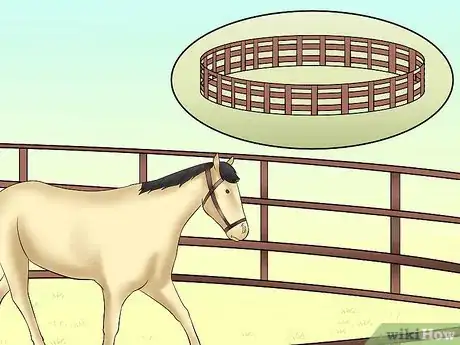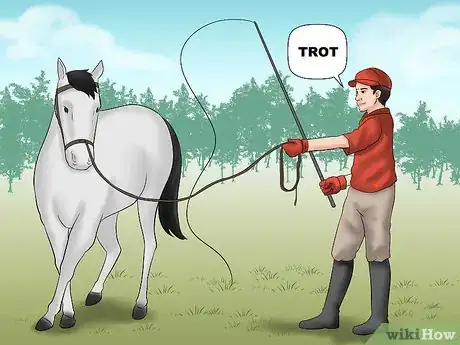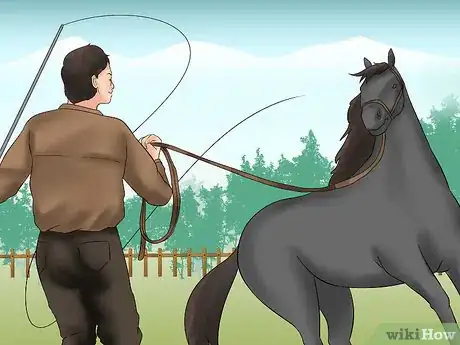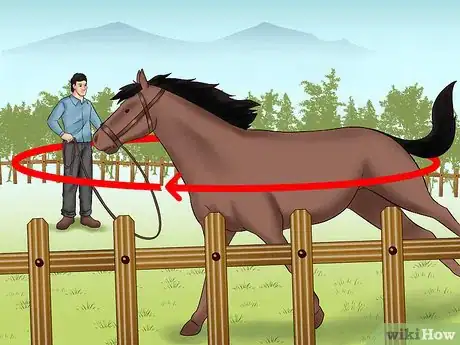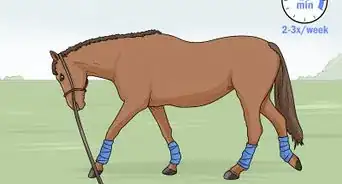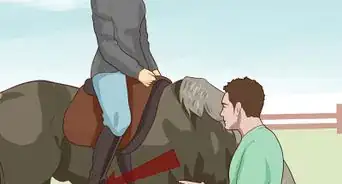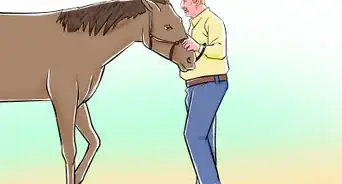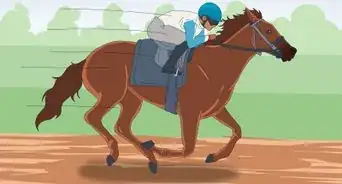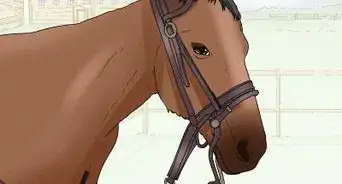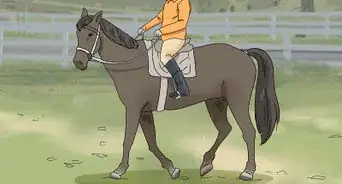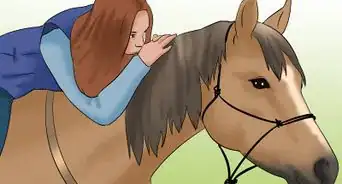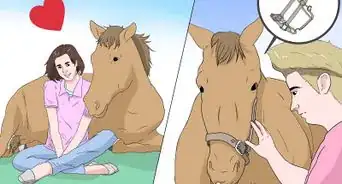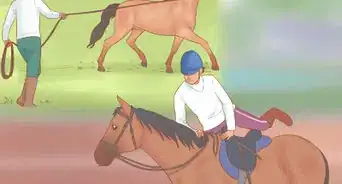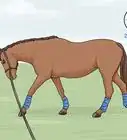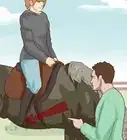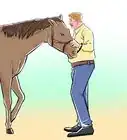This article was co-authored by Ryan Corrigan, LVT, VTS-EVN. Ryan Corrigan is a Licensed Veterinary Technician in California. She received her Bachelor of Science in Veterinary Technology from Purdue University in 2010. She is also a Member of the Academy of Equine Veterinary Nursing Technicians since 2011.
This article has been viewed 113,788 times.
Lunging a horse entails having the horse follow your command to run faster or slower and move in or out of a circle. As the horse's handler, you'll stand in the center of that circle and give commands while holding the other end of the lunge line. Teaching a horse to lunge can be challenging for both you and the horse, and lunging should never be done by an inexperienced horse handler. But with enough time, patience, and adequate space to perform lunging, your horse can learn to walk, trot, and canter on the lunge line in no time.
Steps
Getting the Right Equipment
-
1Acquire a lunge line. The lunge line should be your main method of communication with your horse during lunge training. You'll give your horse subtle direction using the line, just as you would with the reins if you were riding the horse.[1]
- The lunge line should be approximately 25 to 30 feet (7.6 to 9 meters) long and made of lightweight material. It should also come with a swivel snap, though some come with a chain at the end.
- Lunge lines are typically made of cotton webbing, nylon, or a blend of both fibers. Some experts recommend cotton for beginners since it is less likely to twist up or slip from your grip.
- Some lunge lines come with stops along the strap to help you get a better grip on the line, while others do not. This is largely a matter of personal preference and comfort. If your line doesn’t come with these stops, you can add them yourself after the fact by knotting the line at 1 foot intervals toward the end you hold.
- If the lunge line is too short, this will make the circle that the horse is traveling too small and put too much stress on the horse’s ligaments, tendons, and joints, all o which could result in injury.
-
2Select a lunging cavesson. Halters can slip out of place and diminish your control over a horse during lunging.[2] Instead, your horse will need to wear a lunging cavesson while training and exercising on the lunge line. This piece of equipment should have a heavily-padded noseband with a metal ring attached to the top. That ring will be used to attach the lunge line to your horse.
- Have an equestrian expert size and adjust your horse's lunging cavesson to ensure a proper fit.
- A properly fitted cavesson should stay securely fastened and remain in place while still being comfortable to the horse.
- Never fit a lunging cavesson over a grackle/figure 8 noseband. This will be tremendously uncomfortable to the horse and it may reduce your control over the animal.
Advertisement -
3Purchase a lunge whip. The role of a lunge whip is to mimic a rider's leg against the horse's body. It is not used to spur the horse's speed, but to gently urge the horse forward or out along the circle.[3]
- The lunge whip should be approximately six feet (1.8 meters) long and fitted with lashes that measure six to eight feet (1.8 to 2.4 meters) in length.
- The whip also helps keep distance between you and the horse, maintaining the circumference of the circle. This is for the handler’s safety.
-
4Wear leather or suede gloves. It’s important to always wear gloves when lunging a horse. This prevents rope burn on your hands if the horse bolts suddenly or runs off spooked. The gloves can be riding gloves or work gloves, just so long as they fit well and don’t interfere with how you hold the lunge line.
Using a Lunge Line
-
1Hold the lunge line properly. You may instinctively think that wrapping the lunge line around your hand or wrist will help you maintain a better grip, but such a hold is actually quite dangerous. If the horse panics and takes off, you would be dragged along with it or have your hand or fingers broken by the quickly tightening rope. Instead, it's best to hold the line in such a way that you can maintain control but still let go if necessary.[4]
- Fold the lunge line back and forth to create a stack of folded line.
- Feed the line out from the top of your folded line stack and attach that end to your horse.
- Hold the line in the center of the stack and let additional line out as needed. If your horse panics for any reason, let go of the line so you are not dragged.
-
2Position yourself in the circle. Stand in the circle with the lunge line stacked into a folded line and held in one hand. You'll want to stand at the horse's side facing its shoulder. Hold the lead with your hand approximately 2 to 4 inches (5 to 10 centimeters) from the snap.
-
3Use the whip. The lunge whip is one of your most important tools. You'll use it to guide your horse as it lunges in and out of the circle. As you train, make sure you tap your horse's shoulder steadily and consistently.
- Maintain a steady rhythm of one to two taps per second.
- If your horse moves its head, keep tapping its shoulder. As soon as your horse learns to move its shoulder instead of its head, immediately stop tapping.
- Wait a few seconds, then repeat the whole process until your horse learns to follow your cues.
-
4Advance your training. As your horse gets comfortable with the process, you can increase the length of the lunge line. This may take several weeks of consistent practice before your horse gets this comfortable and is ready to advance.
- Hold the line about 10 inches (25 centimeters) from the snap and follow the same procedure.
- Keep practicing until your horse becomes fluent at this length.
- Don’t ask your horse to go at faster speeds until he is comfortable on a 20 meter circle and can hold this in both directions.
Doing Lunge Work in the Circle
-
1Familiarize your horse with the round pen. Your horse has probably been conditioned to always stay with you when it's being led, which can make lunge work confusing for horses at first. Teaching your horse to move around the round pen on its own will help your horse get more comfortable with other steps in the lunging training.
- The best way to get your horse comfortable and familiar with a round pen is to simply set it loose in the space. This lets your horse to see, smell, and check out all the areas of the round pen, which will make him more relaxed.
- Don't hold the reins or strap; simply let it leave your side or return to you as it desires.[5]
- Try using a verbal command like "walk." You can teach a verbal command by giving the cue, encouraging a response to the command, and rewarding the behavior.[6]
- Once your horse is used to roaming around the pen, get your horse comfortable walking the circumference of the round pen and following your command using a lunge whip.
-
2Work up to a trot. Once your horse is comfortable roaming slowly around the round pen on its own, you'll want to work at building your horse's speed. Start out slow and gradually get faster and faster, but make sure you don't sacrifice form for speed.
- Use a lunge whip to teach your horse to trot outside of the circle around you.
- You can also use verbal commands. Say "trot," then tug on the lead while jogging and reward your horse when it responds.[7]
-
3Practice halting. The goal is to get your horse to halt in its path without turning to face you. It may take a while for your horse to get comfortable with halting, so be patient and have faith in your animal.
- Try using your body language to lead the horse back out into the circle. You can also tug on the horse's lunge line to guide it the same way you would tug on the reins.
- Whenever your horse turns and faces you, approach the horse and guide it straight back onto the circular path.
- If you see your horse start to slow or turn in, you can use your lunge whip lightly at the shoulder to encourage him to stay forward and keep moving.
-
4Reinforce the pattern. Once your horse is comfortable working in a round pen, you're ready to take it to a larger space, like a full-size arena. This can take many weeks of dedicated practice for some horses, so be patient and remain consistent in your practice sessions.
Warnings
- Do not overwork your horse.⧼thumbs_response⧽
- Never use lunging as a way for your horse to work off excess energy. Moving out of control on a lunge line is bad for the horse's legs and it teaches the horse how to use its weight and energy to overpower you.⧼thumbs_response⧽
- If you’re lunging in an arena or round pen, make sure that all gates are closed and the area is free of equipment or other things the horse could hurt itself on.⧼thumbs_response⧽
- Make sure small children aren't around while you train your horse to lunge. An excited horse may not be able to stop if a child wanders into the circle.⧼thumbs_response⧽
Things You'll Need
- A horse
- A lunge line
- A lunging cavesson fitted to your horse
- A lunge whip
- A round pen or any other area where your horse cannot escape easily
- An experienced horse trainer
References
- ↑ http://www.doversaddlery.com/overview-of-lungeing-equipment/a/512/
- ↑ http://www.doversaddlery.com/overview-of-lungeing-equipment/a/512/
- ↑ http://www.doversaddlery.com/overview-of-lungeing-equipment/a/512/
- ↑ http://www.doversaddlery.com/overview-of-lungeing-equipment/a/512/
- ↑ http://horsefulnesstraining.com/liberty-training-what-is/
- ↑ http://lorienstable.com/articles/handling/200-voice_commands/
- ↑ http://lorienstable.com/articles/handling/200-voice_commands/
About This Article
To teach your horse to lunge, stand in the circle with the lunge line stacked into a folded line. Hold the line firmly in one hand without wrapping it around your wrist so you can let additional line out as needed. Next, stand at the horse's side, facing its shoulder, and hold the lead 2-4 inches from the snap. Then, guide your horse with the lunge whip, tapping its shoulders steadily and consistently, as it lunges in and out of the circle. You can increase the length of the lunge line as your horse gets more comfortable. For more tips on doing lunge work in the circle, read on!

